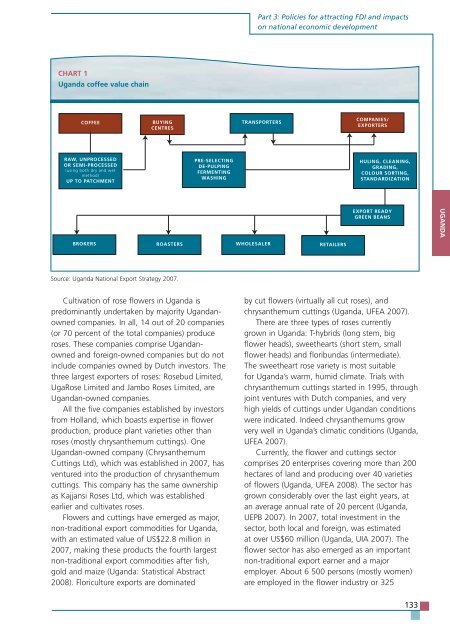TRENDS AND IMPACTS OF FOREIGN INVESTMENT IN DEVELOPING COUNTRY AGRICULTURE
TRENDS AND IMPACTS OF FOREIGN INVESTMENT IN DEVELOPING COUNTRY AGRICULTURE
TRENDS AND IMPACTS OF FOREIGN INVESTMENT IN DEVELOPING COUNTRY AGRICULTURE
Create successful ePaper yourself
Turn your PDF publications into a flip-book with our unique Google optimized e-Paper software.
CHART 1<br />
Uganda coffee value chain<br />
C<strong>OF</strong>FEE BUY<strong>IN</strong>G<br />
CENTRES<br />
RAW, UNPROCESSED<br />
OR SEMI-PROCESSED<br />
(using both dry and wet<br />
method)<br />
UP TO PATCHMENT<br />
Source: Uganda National Export Strategy 2007.<br />
PRE-SELECT<strong>IN</strong>G<br />
DE-PULP<strong>IN</strong>G<br />
FERMENT<strong>IN</strong>G<br />
WASH<strong>IN</strong>G<br />
Cultivation of rose flowers in Uganda is<br />
predominantly undertaken by majority Ugandanowned<br />
companies. In all, 14 out of 20 companies<br />
(or 70 percent of the total companies) produce<br />
roses. These companies comprise Ugandanowned<br />
and foreign-owned companies but do not<br />
include companies owned by Dutch investors. The<br />
three largest exporters of roses: Rosebud Limited,<br />
UgaRose Limited and Jambo Roses Limited, are<br />
Ugandan-owned companies.<br />
All the five companies established by investors<br />
from Holland, which boasts expertise in flower<br />
production, produce plant varieties other than<br />
roses (mostly chrysanthemum cuttings). One<br />
Ugandan-owned company (Chrysanthemum<br />
Cuttings Ltd), which was established in 2007, has<br />
ventured into the production of chrysanthemum<br />
cuttings. This company has the same ownership<br />
as Kajjansi Roses Ltd, which was established<br />
earlier and cultivates roses.<br />
Flowers and cuttings have emerged as major,<br />
non-traditional export commodities for Uganda,<br />
with an estimated value of US$22.8 million in<br />
2007, making these products the fourth largest<br />
non-traditional export commodities after fish,<br />
gold and maize (Uganda: Statistical Abstract<br />
2008). Floriculture exports are dominated<br />
Part 3: Policies for attracting FDI and impacts<br />
on national economic development<br />
TRANSPORTERS<br />
BROKERS ROASTERS WHOLESALER RETAILERS<br />
COMPANIES/<br />
EXPORTERS<br />
HUL<strong>IN</strong>G, CLEAN<strong>IN</strong>G,<br />
GRAD<strong>IN</strong>G,<br />
COLOUR SORT<strong>IN</strong>G,<br />
ST<strong>AND</strong>ARDIZATION<br />
EXPORT READY<br />
GREEN BEANS<br />
by cut flowers (virtually all cut roses), and<br />
chrysanthemum cuttings (Uganda, UFEA 2007).<br />
There are three types of roses currently<br />
grown in Uganda: T-hybrids (long stem, big<br />
flower heads), sweethearts (short stem, small<br />
flower heads) and floribundas (intermediate).<br />
The sweetheart rose variety is most suitable<br />
for Uganda’s warm, humid climate. Trials with<br />
chrysanthemum cuttings started in 1995, through<br />
joint ventures with Dutch companies, and very<br />
high yields of cuttings under Ugandan conditions<br />
were indicated. Indeed chrysanthemums grow<br />
very well in Uganda’s climatic conditions (Uganda,<br />
UFEA 2007).<br />
Currently, the flower and cuttings sector<br />
comprises 20 enterprises covering more than 200<br />
hectares of land and producing over 40 varieties<br />
of flowers (Uganda, UFEA 2008). The sector has<br />
grown considerably over the last eight years, at<br />
an average annual rate of 20 percent (Uganda,<br />
UEPB 2007). In 2007, total investment in the<br />
sector, both local and foreign, was estimated<br />
at over US$60 million (Uganda, UIA 2007). The<br />
flower sector has also emerged as an important<br />
non-traditional export earner and a major<br />
employer. About 6 500 persons (mostly women)<br />
are employed in the flower industry or 325<br />
133<br />
UG<strong>AND</strong>A


